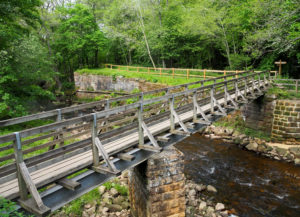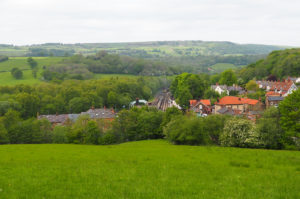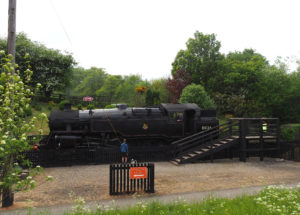This is a lovely “walk”:http://www.thenorthernecho.co.uk/resources/files/29469 along a well made footpath suitable for pushchairs and wheelchairs. Do it from Goathland as it is downhill all the way!
Beginning in Goathland village, the route begins by following Beck Hole Road past the car park. Just beyond, there is gate and signpost onto the rail trail.
The trail then crosses the unclassified road to Darnholme and the start of the famous Beck Hole Incline. The trail follows the West Beck downhill through attractive deciduous woodland. At the end of May, the trees had only just come into leaf and the ground was covered with wild garlic and cow parsley. The trail follows the West Beck downhill.
At the bottom of the incline, the trail passes the stone built Incline Cottage. Just beyond is a small orchard planted by the Beckhole Woodland and Heritage Foundation. The area had been famous for its orchards with visitors enjoying a picnic under the apple trees.
Beyond the orchard is the site of Beck Hole Station, which is a short distance from the settlement of Beck Hole. After the new line was opened, the rails were not lifted along the Grosmont to Beck Hall Station section and tourist trains continued to run to Beck Hole between 1908-1914, bring visitors from Whitby to enjoy the local waterfall and tea gardens.
A footpath leads up to Beck Hole, a delightful small settlement set in a steep wooded valley around an old fording point on the Eller Beck. There are a few old stone built cottages and the “Birch Hall Inn”:http://beckhole.info/bhi.htm, which has a small shop selling sweets, soft drinks and ice creams .
Just beyond the station was the site of Beck Hole Ironworks, a short lived venture that closed in 1864. This is much more open countryside with sheep grazing between the hawthorn.
Beyond Beck Hole, the West Beck is crossed by a bridge, although the original stepping stones are still ther – great fun for the younger members….
The West Beck and Eller Beck join to form the Muir Esk and the trail now follows this, crossing the river at North Bridge. The substantial stone bridge was built to carry the weight of steam engines was washed away in heavy floods. Now all that remains are the bridge abutments and posts in the stream bed. It is now crossed by a modern pedestrian footbridge.
Approaching Grosmont, the railway passes the site of the Muirside Ironstone mines. The small row of cottages at Esk Valley housed workers at the mines.
The track now runs along side the North York Moors line with a cast iron plaque marking the start (or end) of the original track. There are views down onto the sidings of the works with its coaling plant.
The track climbs up over the tunnel to a view point overlooking Grosmont – the only uphill bit of the walk.
Before the arrival of the railway, Grosmont didn’t exist, with just a few scattered farms. With the coming of the railway and the discovery of ironstone, Grosmont became an important industrial centre with iron works, kilns and brick works in the late C19th. The ironstone was short lived boom a the works closed in 1891. The piles of slag were reprocessed to be used for road building. The brick works survived until 1957, making a very hard and dense brick that was impossible to drill.
The track drops down into Grosmont past a small viewing area near the loco sheds.
Grosmont is now a small rather forgotten village with few facilities apart from the the North York Moors Railway and the Esk Valley line to Middlesborough. Its main claim to fame now seems to be the Grosmont Co-operative Society shop, opposite the station, which proclaims itself to be Britain’s oldest independent co-operative, established in 1867.
There are plenty of seats along the trail and refreshments are available at Birch Hall Inn and the refreshment room on Grosmont Station. Catch the train back to Goathland!










